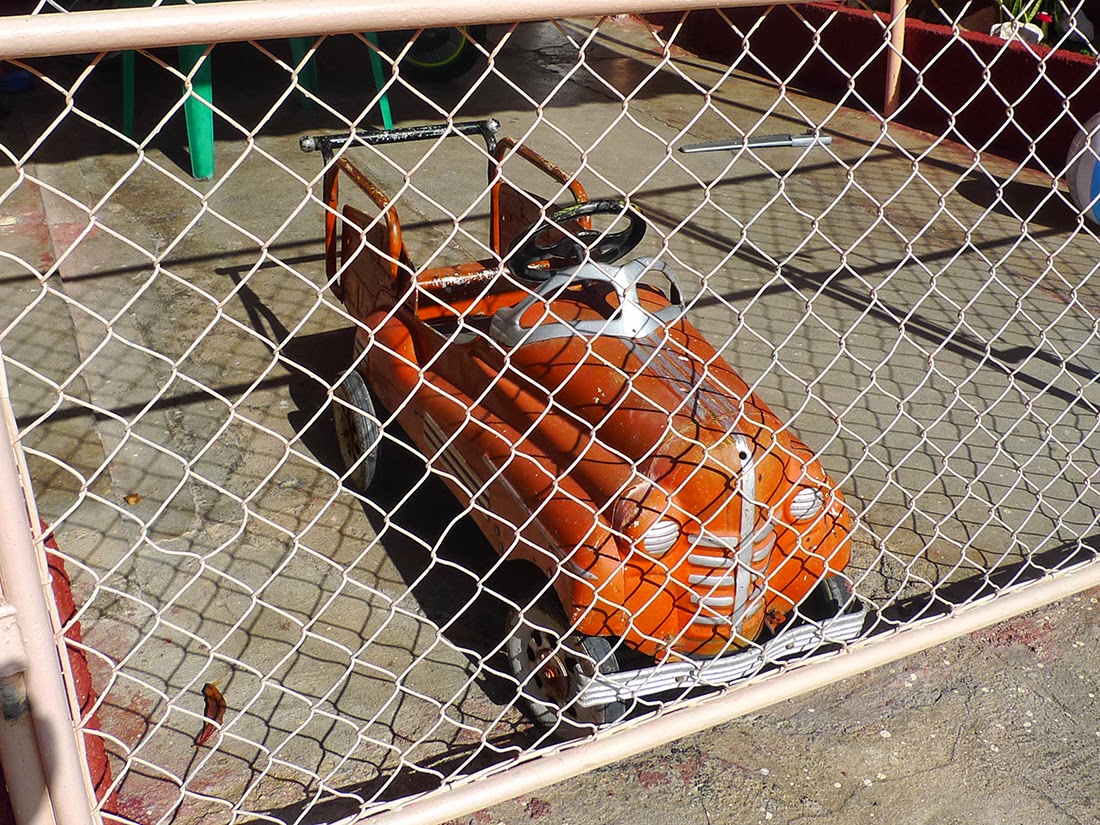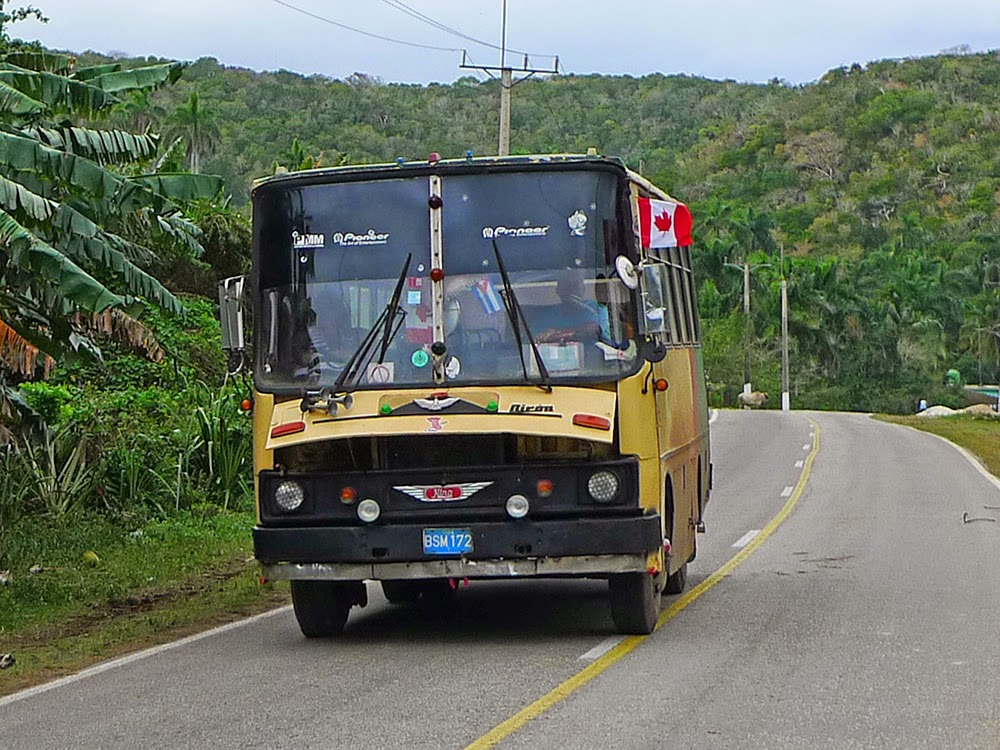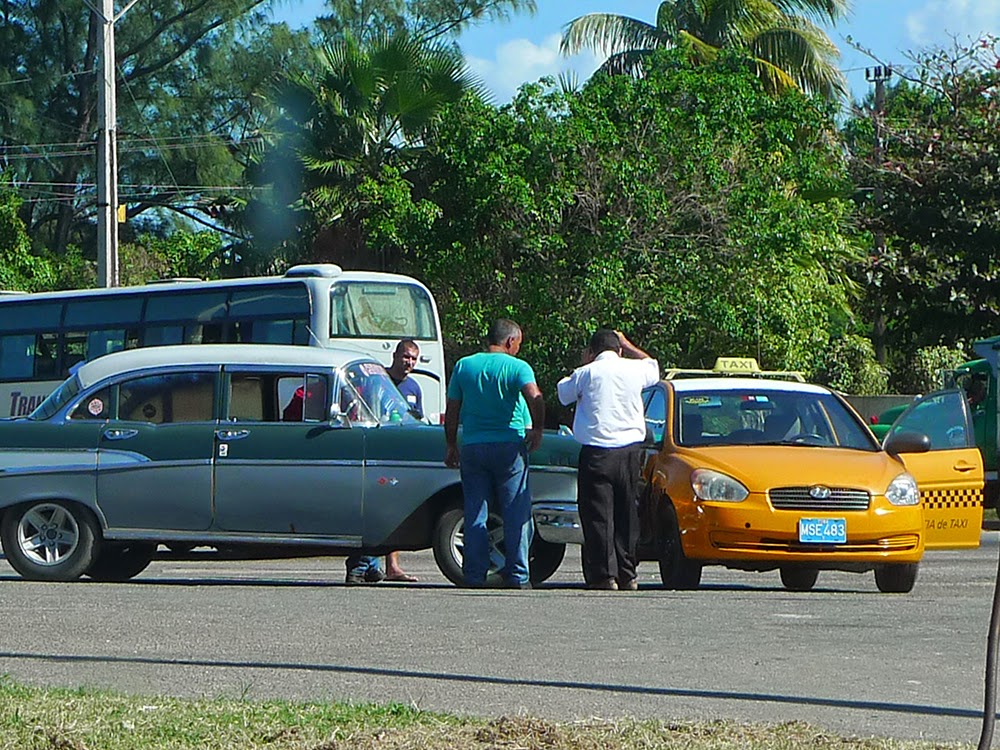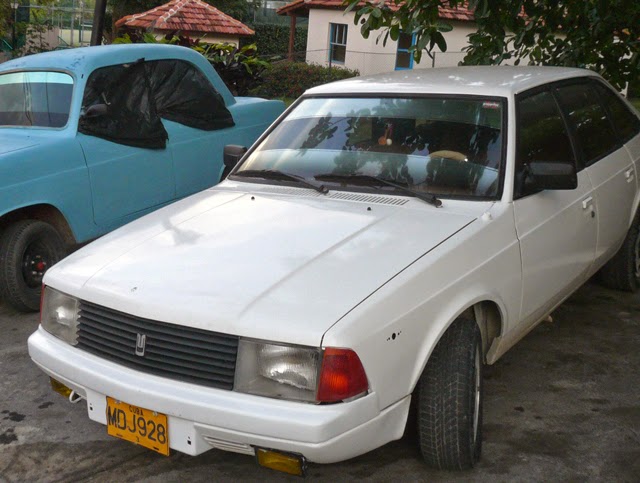↧
In Cuba, even the toy cars are classics
↧
It's a cute little rascal init?
Pretty sure the pedal car from the last entry is a 1941 Steelcraft Pontiac station wagon, same as the one in this video from cheerful Texas banjo-picker R. Peek. Wee doggies!
↧
↧
Diani's Chinese bicycle
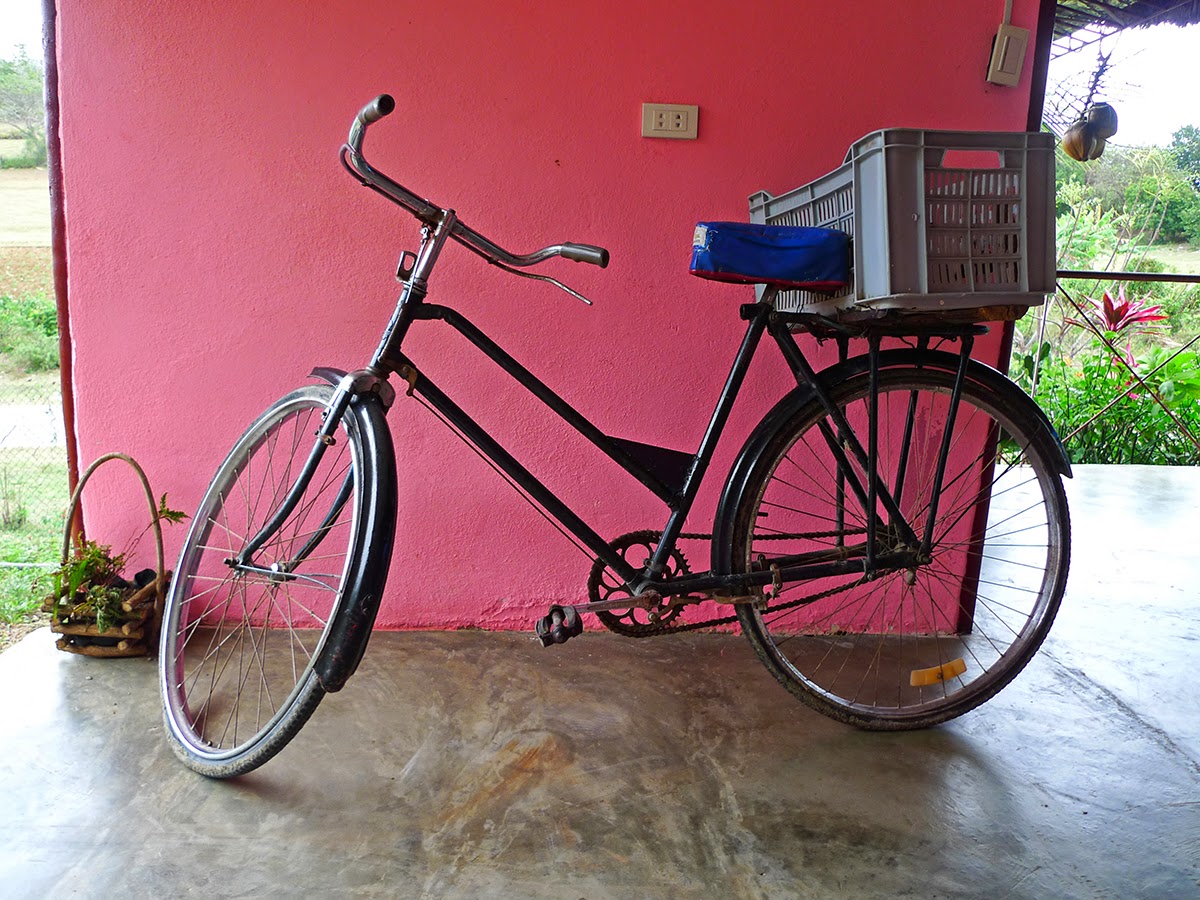 |
| Bikes imported from China included the Phoenix, the Forever and the Flying Pigeon, above. |
When the Soviet Union came crashing down, an island on the other side of the world felt the shock waves. For three decades, Cuba had relied on aid from the USSR and its Eastern European satellites.
Now those infusions – approaching an estimated $5 million a day at their peak – had disappeared, and Cuba was short on food, medicine, and especially, oil. Without cut-rate Soviet petroleum, the island could not operate its farm tractors, its municipal buses, even its power stations.Cubans adapted. In the grim years that Fidel Castro would call a "Special Period in Time of Peace," they structured their lives around daily power blackouts. They lost weight – 15 pounds per adult, it's been said – on a meagre diet of staples like pasta de oca: a mix of flour and tiny bits of ground goose.
And to get around, they rode Chinese bicycles. According to the International Bicycle Fund, between 1991 and 1997 Cuba imported 1.5 million two-wheelers, primarily from China, while producing an additional 500,000 bicycles of its own.
In the years since the Special Period, Cuba found a new (if lately, shaky) source of cheap oil in Venezuela, and new income from tourism and resources. Yet reminders of that time persist in the buildings that decayed beyond repair, and the waste-nothing attitude that every Cuban brings to food.
And they persist in the bicycles like this Flying Pigeon, still in regular use and converted at some point from a man's bicycle to a woman's to suit Diani or some earlier skirt-favouring rider.
Not a minor alteration, but Cubans do know how to adapt.
↧
Their daily fix
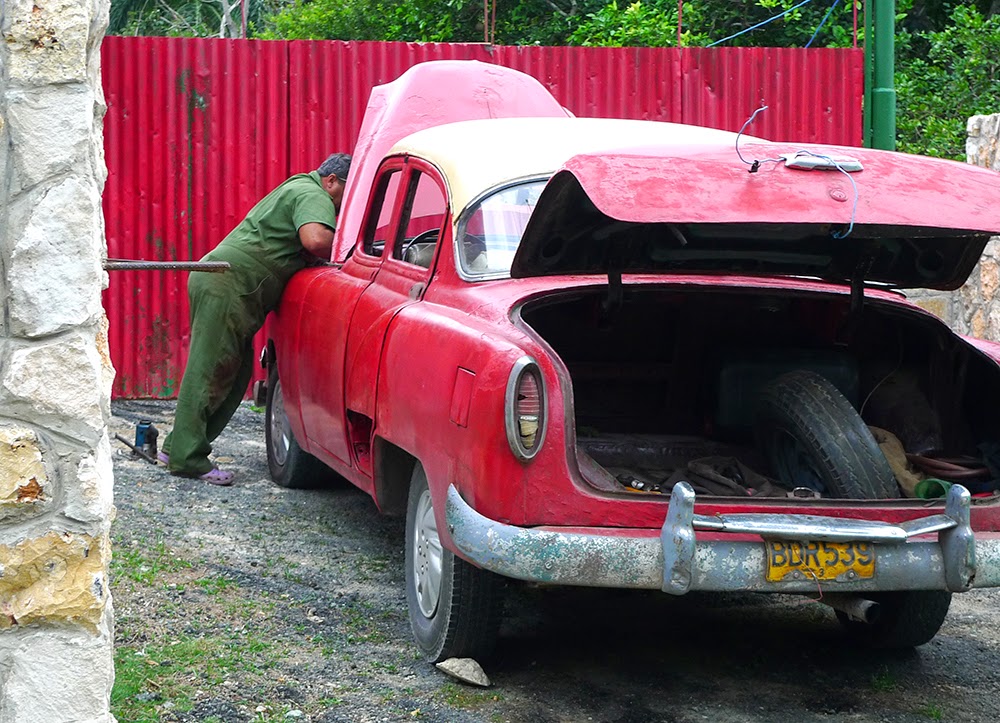 |
| Door repair will have to wait until engine work is complete on this 1953 Dodge. |
Where I live, I don't see many people fixing their own vehicles. Cars break down less frequently than they did even in the 1960s and '70s (take a bow, fuel injection and electronic ignition). And when they do stop working, the cause is usually something that cannot be addressed, even temporarily, with some friction tape or a length of pantyhose.
It's different in Cuba, where cars are old and parts and money are scarce. Own a vehicle in Cuba, and you had better know how to repair it.| Committee consults on stalled Moskvich in Miramar. |
 |
| In Old Havana, the owner of an ailing '52 Chevrolet gets advice from the local beat cop. |
↧
Daily Fix, 2
| Cubans are adept at keeping their Ladas going. They've had years of practice. |
 |
| Another Lada pit stop. Once fixed, this one will be ready for a tank of leaded "Black Gold" gasoline. |
↧
↧
Daily Fix, 3
| A 1953 Plymouth gets some attention in Havana. |
 |
| Newer vehicles are not immune from breakdowns. |
↧
Cuba's Dream Cruise
It doesn't yet rival Detroit's annual event, but the Rusty Nuts Cuba Car Show gets bigger by the year. This year more than 100 vehicles showed up for the exhibition and cruise at Santa Cruz del Norte, east of Havana, and as the video below reveals, a fine time was had by all.
Photos, videos from previous shows:
↧
A year of Cuban classics
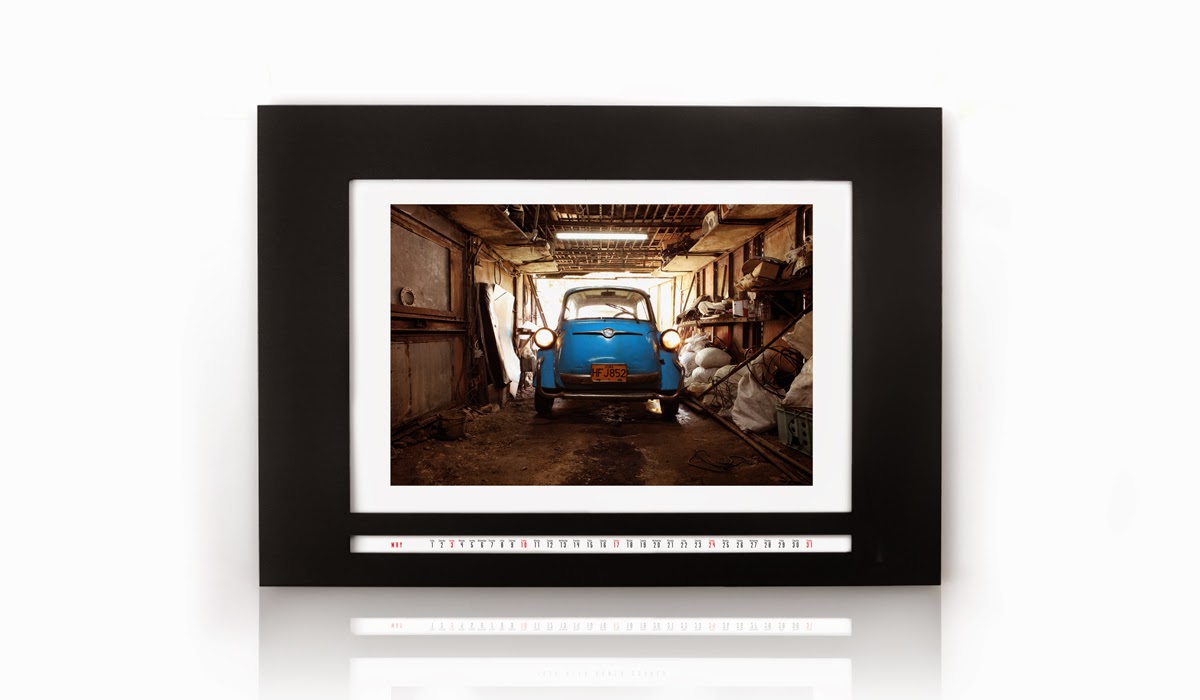 |
BMW Isetta is the subject for May in the 2015 Degler Calendar. |
You might not get to Cuba as often as you wish. Perhaps you don't get there at all.
But with the 2015 Degler Calendar, a premium offering from photographer Piotr Degler Jablonski, you still can spend time with 12 remarkable images from the island of classic vehicles.
Jablonski is based in Turin, Italy, where he previously worked as a designer for the renowned Bertone auto styling house and coachbuilder. In 2013 he struck upon the idea of producing a calendar with a different automotive theme each year, and Bertone's concept cars were an easy choice as his first subject.
For his second edition Jablonski went farther afield, travelling the length of Cuba and taking thousands of shots, from which he culled 12 images that portray the island's cars in all their bright dignity.
The calendar is printed on heavy stock in Italy and costs 65 euros ($81 U.S. at this writing) plus shipping. It's also available in a black anodized frame for 165 euros ($206), or in a numbered "collector's edition" frame with handsome, Cuba-correct stabilized-rust finish for 300 euros ($375).
For car-lover or Cuba-lover, this would make a nifty gift (even if the recipient is yourself). Order the 2015 edition at www.deglercalendar.com.
 |
From thousands of shots, Jablonski chose 12 for the second edition of the Degler Calendar. |
Photos ©Piotr Degler Jablonski. Used by permission.
↧
25,000 photos, and the world's only known derelict Mercedes Gullwing
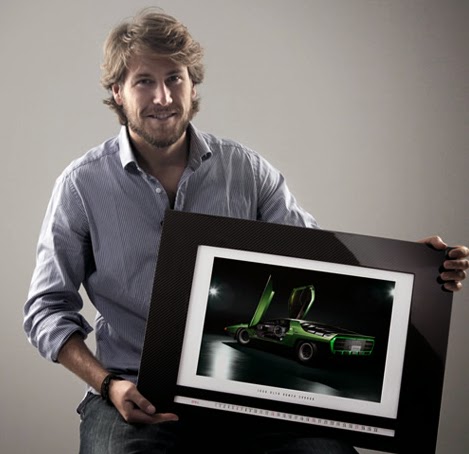 |
| Piotr Degler Jablonski with the 2014 calendar. |
Q: Tell us how someone with a Polish name and Spanish upbringing finds himself an automotive photographer working out of Turin, Italy.
A:I was born in Poland and have some German heritage as well. Both of my parents are musicians, and when I was two we moved to Spain. I grew up there and studied at the German School. My interests have always been cars and photography. At age 19 I moved to Italy to study car design and I then worked for several years as car designer. In the meantime I also worked as a car photographer for different car companies and magazines worldwide. Today photography is my full-time life.
Q: How did the Delger Calendar come about? Was the Pirelli Calendar an influence?
A:The initial project was a book featuring 100 unique cars, but I thought a calendar in the meantime could be quicker to create. Obviously Pirelli is a great calendar, but focused essentially on women's beauty. If you think about a car calendar, nothing very strong comes to your mind. There are a lot of car companies producing their own calendars, but those can look nearly the same year after year.
 |
| Keepsake: Numbered Collector's Edition. |
I wanted to create something different, a calendar that every year explores a new and exclusive automotive theme. Even if you are not familiar with the theme, you will discover something new. The goal as well was to offer something very special — that's why you can choose between the Standard (without frame) , Exclusive (black anodized aluminum frame) and Collector's Edition (rusted aluminum frame and numbered plate).
Q: Why Cuba as the 2015 theme?
A:The 2014 theme was "Concept Cars by Bertone"; 12 prototypes designed by the famous Italian coachbuilder, photographed in the dark in different studios around the world. For 2015 it was nice to find a completely different theme, even changing the style of photography from studio work to reportage.
I always wanted to visit Cuba, as I am a big fan of 1950s American cars. I thought this contrast from last year's edition would work well, and I also thought it was the right moment to do it.
I always wanted to visit Cuba, as I am a big fan of 1950s American cars. I thought this contrast from last year's edition would work well, and I also thought it was the right moment to do it.
Q: How long were you in Cuba, and how many images did you take?
A:I spent one month on the island looking for the most interesting cars. I wanted to show not only the American classics but also what can be hidden from tourists' eyes. Visiting Cuba from Viñales to Santiago de Cuba, every day in a new location, was an experience I will never forget.
 |
| For April, a Chevrolet convertible. |
In total I took about 25,000 images. It was not easy to summarize all of this project with only 12 snapshots. On the one hand, photographs showing the human side, the people, the environment, cars maintained with inventiveness and necessity for decades ... on the other, obsolescent cars showing what they once were and dreaming of what they could be again.
Q: There's an honest, even vernacular sense to your Cuba images. How important was it to avoid overly staged scenes and after-the-fact manipulation?
A:I am accustomed to offering a commercial look for my clients. Most of them seek a brochure-like image for their latest commercial campaign, so there's usually a lot of postproduction work required. I try to get the right balance avoiding over-postproduction – a very diffused look nowadays.
"Carros de Cuba" was a chance to show the purity of photography. You don't need to sell anything, just show the reality as it is. For me it is a documentary work, I wanted to show how Cuba and its cars appear in 2014. Natural and improvised photographs, no forced elements placed in the frame for the occasion, everything happening by chance, natural colours, unretouched photographs ...
Q: What was your biggest surprise about Cuba and its cars?
A:My first surprise when I arrived at the airport at night was seeing the large number of classic cars on the road. I really didn't expect to still see so many of them. I felt like a little boy on Christmas Day! Every day was a big surprise in Cuba.
Q. Tell us about photographing Cuba's famously derelict Mercedes Gullwing Coupe.
 |
| Moonlit Mercedes-Benz 300SL Gullwing. |
A:I've heard about the Gullwing before starting the project. I thought it would be great to show it in the calendar, as you can't find a unrestored Gullwing anymore! It took nearly four weeks to find it; nobody really knew about the car. After travelling the whole island from west to east and asking everybody I met on my way, I finally found it just a couple of days before I was to leave. I first saw it during the day, sleeping under a banana tree, rusted, almost gone ... I thought, "It deserves to be photographed by night, it would look nice for the December month." So that's what I did.
Q. When will you return to Cuba?
A:I hope soon. I encourage every car enthusiast to go to Cuba.
Photos © Piotr Degler Jablonski. Used by permission.
↧
↧
The Cuba Gullwing chronology
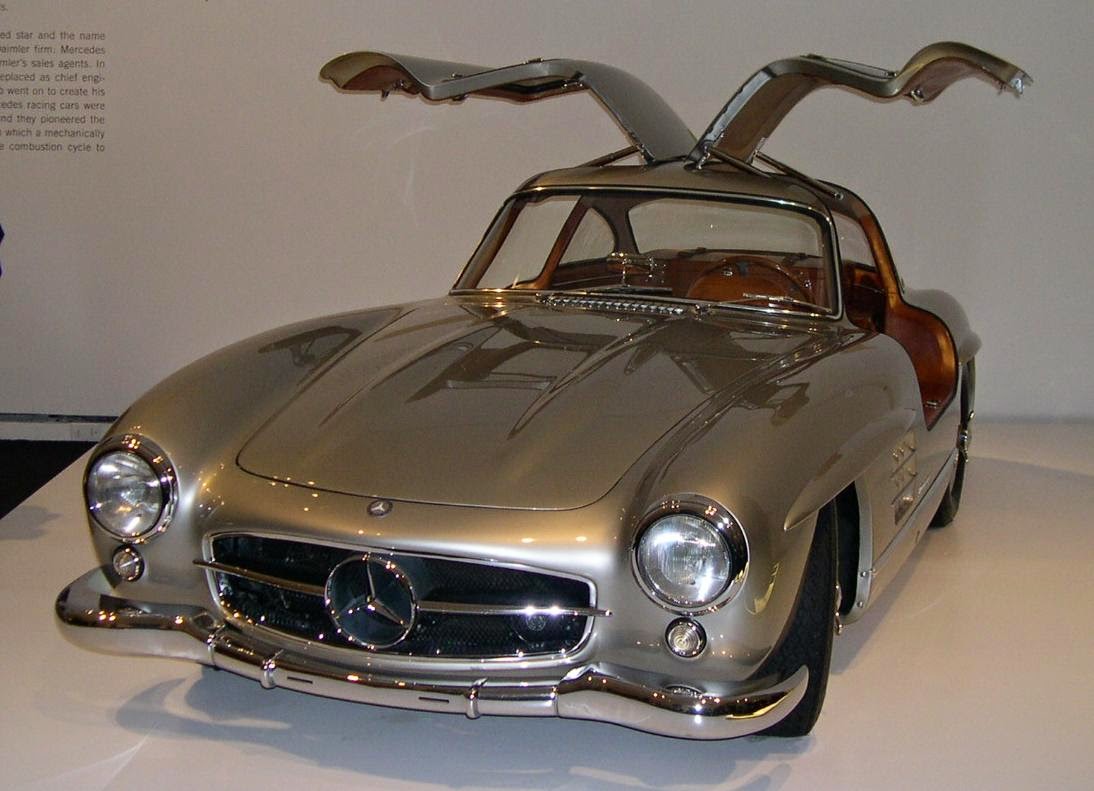 |
| How the 300SL would have looked new. Wikipedia photo. |
The same analytics program that tells me the home nations of these visitors tells me where they land – and it's apparent that many are missing the full story (or as full as anyone has been able to make it). The world's largest Internet indexer – you know who I'm talking about – insists on routing the curious to a five-year post and refuses to make note of subsequent entries.
Why? Who knows?
To provide a more complete picture, here's a list of CARISTAS entries on the Gullwing, which, to be clear, was first brought to the world's attention by British auto historian Michael E. Ware in Automobiles Lost & Found (Haynes Publishing, 2008).
Why? Who knows?
To provide a more complete picture, here's a list of CARISTAS entries on the Gullwing, which, to be clear, was first brought to the world's attention by British auto historian Michael E. Ware in Automobiles Lost & Found (Haynes Publishing, 2008).
Michael E. Ware shares details of the his visit to a district near Havana to see the silver Gullwing rusting amidst scrap outside a private garage. Location scout Tony Robertson tells of his own unsuccessful search for this same Gullwing. Links (one now defunct, unfortunately) offer views of two Gullwings in competition events in Cuba in 1957.
Dec. 13, 2009: Gullwing bits and pieces More photos of the Gullwing and numerous 300SL parts in the same yard, as provided by Michael E. Ware.
April 7, 2010: Tracking the Gullwing
A potential clue to the car's history is found in a novel by Rachel Kushner.
June 14, 2010: Elvis in a Gullwing in Havana
A link to Pieralfonso Longo's photo from years earlier of a Cuban official in another 300SL Gullwing in Havana. Follow the link; you will not be disappointed.
Dec. 9, 2012: Gullwing and a prayer
World traveller Miguel Loriente, aided by clues from CARISTAS entries, sets out to locate the Gullwing.
Dec. 16, 2012: The young man and the 300SL
Miguel Loriente locates the Gullwing at a different site. The frame is twisted, the body riddled by corrosion. Still, says Miguel, finding the Gullwing has been "one of the most rewarding experiences of my life."
Feb. 5, 2013: The Gullwing: Watch it and weep
Miguel Loriente's YouTube video of the crumbling car.
Nov. 10, 2014: 25,000 photos, and the world's only known derelict Mercedes Gullwing
The Gullwing resurfaces, this time in the 2015 Degler Calendar by Piotr Degler Jablonski. In an interview, the young photographer describes his month-long mission to find the car.
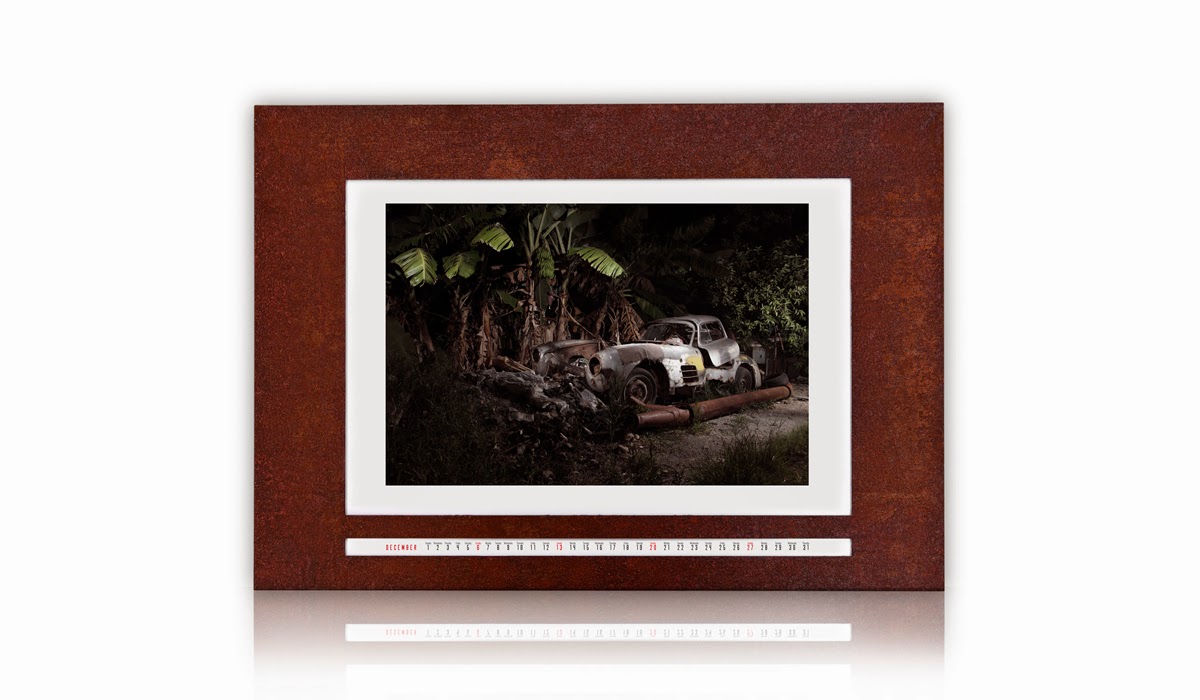 |
| Captured for a calendar. Piotr Degler Jablonski photo. |
↧
An (almost) Cuban taxi in Toronto
I've never seen a Checker Marathon in Cuba. That's probably because the Marathon, built in Kalamazoo, Mich., didn't go on sale until September 1961, more than a year after the direct export of U.S. vehicles to Cuba ended.
But the Marathon's 1950s styling makes it look like a Cuban cab, at least to the Toronto residents who hopped into the Checker that Transat Holidays put on the streets of the Canadian city to promote its winter sun excursions. And the actors playing the driver and his friends are certainly convincing.
The video makes me think of an earlier commercial that just might have been the inspiration for the Transat campaign. SeeThe Lost Chevy Commercial.
↧
Stubborn old goat
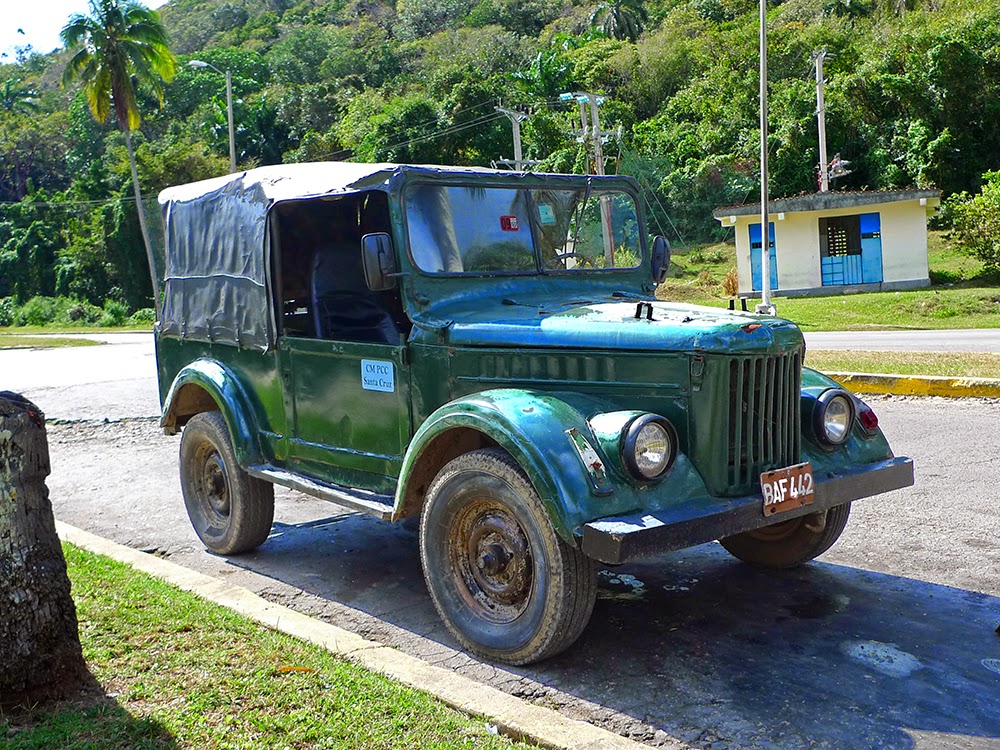 |
| Russian-built GAZ-69 was introduced in 1953, with a design from an earlier era. |
In Russia, the nickname for the GAZ-69 is "Kozel," or male goat. It is not a compliment.
Call someone a kozel, and you are suggesting he is stubborn and stupid.
When the name is applied to this prosaic four-by-four, however, there could be some admiration mixed with the disdain. As this battered Cuban example attests, the Kozel is virtually unkillable. And despite its tractor-like looks, the Kozel is said to have a surprisingly soft ride, thanks to long leaf springs fore and aft.
The GAZ-69 was introduced in 1953 as the Russian army's basic light off-road truck. Its styling looked dated even then, reflecting a long, seven-year development period.
Production began at the Gorky Automobile Factory but soon moved to UAZ (Ulyanovsk Automobile Plant). Between the two, more than 630,000 Kozels would be assembled by the end of production in 1972. Variants were also built by Romania's ARO, with the last model, recognizable by its one-piece windshield, produced until 1975.
Powering the first GAZ-69 was a 2.1-litre inline four-cylinder gas engine producing 55 h.p. Later a 2.4.-litre four-cylinder rated at 65 h.p. was introduced. Throughout, the 69 had a three-speed manual transmission and two-speed transfer case.
According to www.gaz69.org, Kozels were exported to 56 countries for military and civilian use. Among those destinations was Cuba, where GAZ-69s like this government vehicle remain in service ... too stubborn, it would seem, to surrender.
When the name is applied to this prosaic four-by-four, however, there could be some admiration mixed with the disdain. As this battered Cuban example attests, the Kozel is virtually unkillable. And despite its tractor-like looks, the Kozel is said to have a surprisingly soft ride, thanks to long leaf springs fore and aft.
The GAZ-69 was introduced in 1953 as the Russian army's basic light off-road truck. Its styling looked dated even then, reflecting a long, seven-year development period.
 |
| Three-speed gearbox, dual-range transfer case. |
Powering the first GAZ-69 was a 2.1-litre inline four-cylinder gas engine producing 55 h.p. Later a 2.4.-litre four-cylinder rated at 65 h.p. was introduced. Throughout, the 69 had a three-speed manual transmission and two-speed transfer case.
According to www.gaz69.org, Kozels were exported to 56 countries for military and civilian use. Among those destinations was Cuba, where GAZ-69s like this government vehicle remain in service ... too stubborn, it would seem, to surrender.
 |
| With long leaf springs atop the solid axles, the ride is surprisingly supple. |
↧
Máquina de misterio
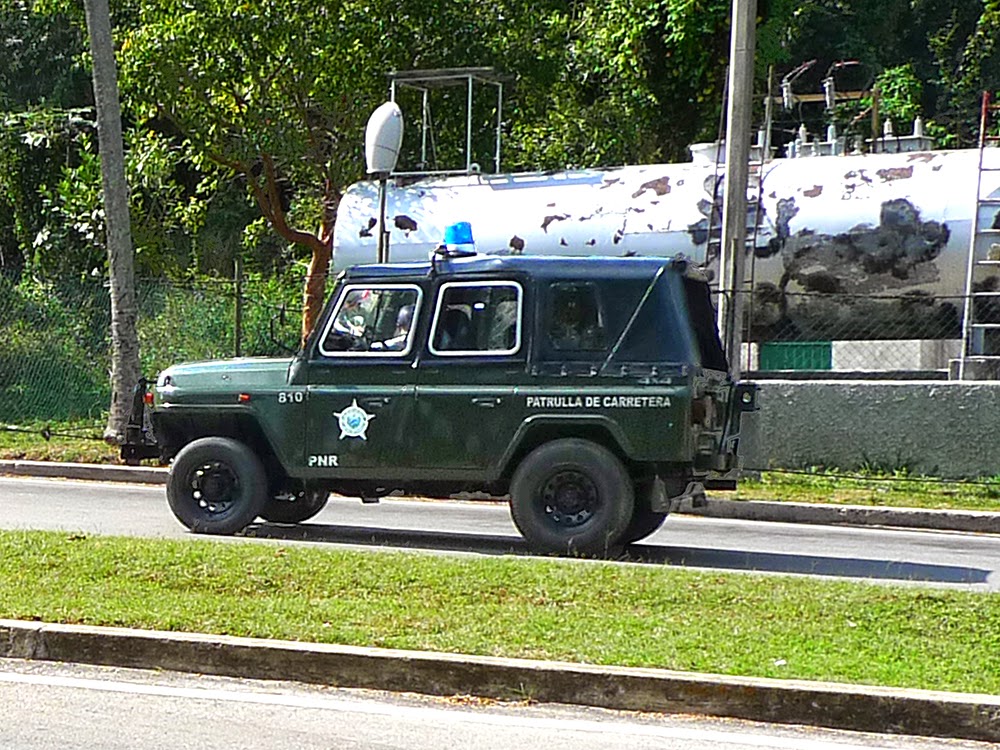 |
| A special, Cuba-only UAZ 469? Or something else entirely? |
In early episodes of television's Highway Patrol, Broderick Crawford as Chief Dan Mathews drove a 1955 Buick Model 68 Century, a police-only two-door sedan with 322-cubic-inch V-8 engine.
Young car watchers (here!) had no trouble identifying it, or any of his later rides that ranged from Plymouths and Dodges to Oldsmobiles and Mercurys.But this Cuban Patrulla de Carretera truck has me stumped.
From Russia or one of its former satellites? Has to be. But I've gone through the Soviet catalogue from ARO to Zil without putting a name to this square-rigged four-by-four.
Closest, maybe, is the UAZ 469 that succeeded the GAZ-69 army truck of the last post. But the Cuban police vehicle is chunkier, with straight-cut wheel openings in place of the 469's more angled fenders. And its door handles are lower.
I did learn that UAZ had – maybe still has – an assembly plant in Camaguey, Cuba, the Empresa Reparadora José Smith Comas. Usually this sort of satellite facility bolts together "knock-down kits" from the parent plant, with little deviation from the original design.
Maybe, though, the Camaguey plant was allowed to put its own stamp on the Russian product, and the Patrulla truck is a Cuban police-only UAZ 469. Or maybe not, in which case I hope someone can say what it is.
One thing for certain. It's no Buick Century.
 |
| Chief Mathews and his police-special Buick. |
↧
↧
Yes, they say, but what about the cars?
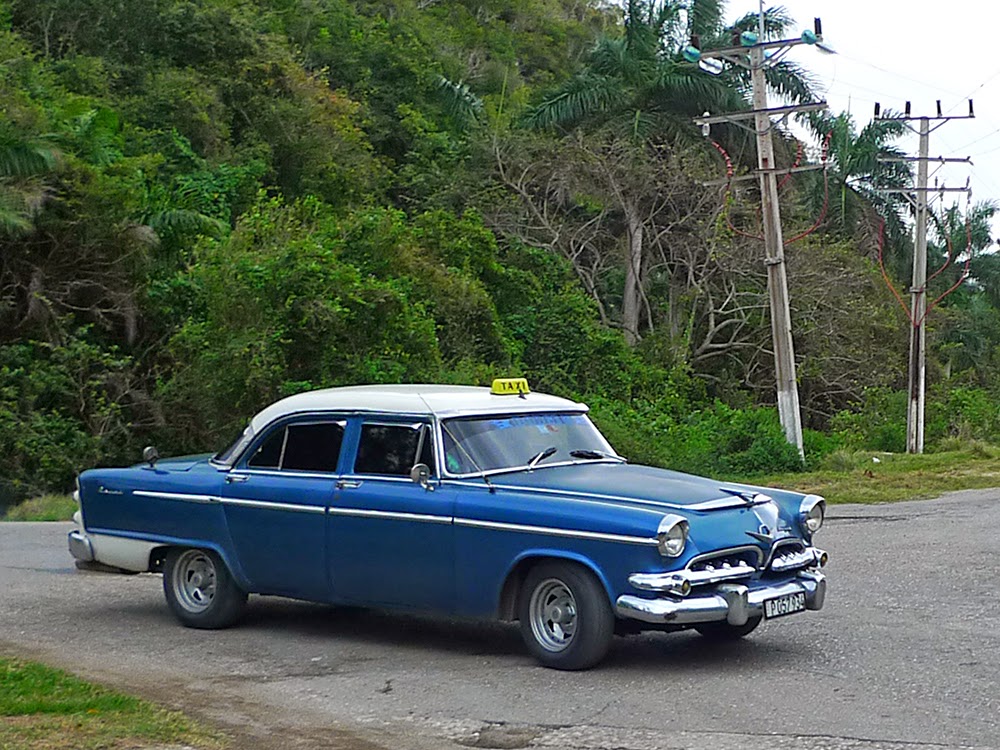 |
| Not ready for retirement, a 1955 Dodge taxi looks for tourist fares. |
"The Era Of Cuba's Classic American Cars May Be Coming To An End"– Business Insider
"How Long Can Cuba's Beautiful Classic Cars Last?"– CNN
"Cuba Trade Could Benefit Car Collectors, Automakers"– USA Today
C'mon folks. While people might expect such speculation from, well, car-crazy blogs like this, they look to organizations like yourselves for broader perspective on today's historic announcements from Barack Obama and Raúl Castro about the thawing of a 54-year ice age.
Then again, the ancient, pre-revolution American autos that still serve so many Cubans are what many outsiders think of first when the topic of the Caribbean island nation arises.
What will happen to the old cars? It's far too early to say.
But to answer CNN's question ... a whole lot longer, if necessary.
"Cuba Trade Could Benefit Car Collectors, Automakers"– USA Today
C'mon folks. While people might expect such speculation from, well, car-crazy blogs like this, they look to organizations like yourselves for broader perspective on today's historic announcements from Barack Obama and Raúl Castro about the thawing of a 54-year ice age.
Then again, the ancient, pre-revolution American autos that still serve so many Cubans are what many outsiders think of first when the topic of the Caribbean island nation arises.
What will happen to the old cars? It's far too early to say.
But to answer CNN's question ... a whole lot longer, if necessary.
↧
What price significance?
Amidst much breathless speculation about the impact of the new détente on Cuba's classic cars, Time reporter Jacob Davidson offers this cogent, well-researched assessment of their desirability to collectors. Bottom line? Um ... not much.
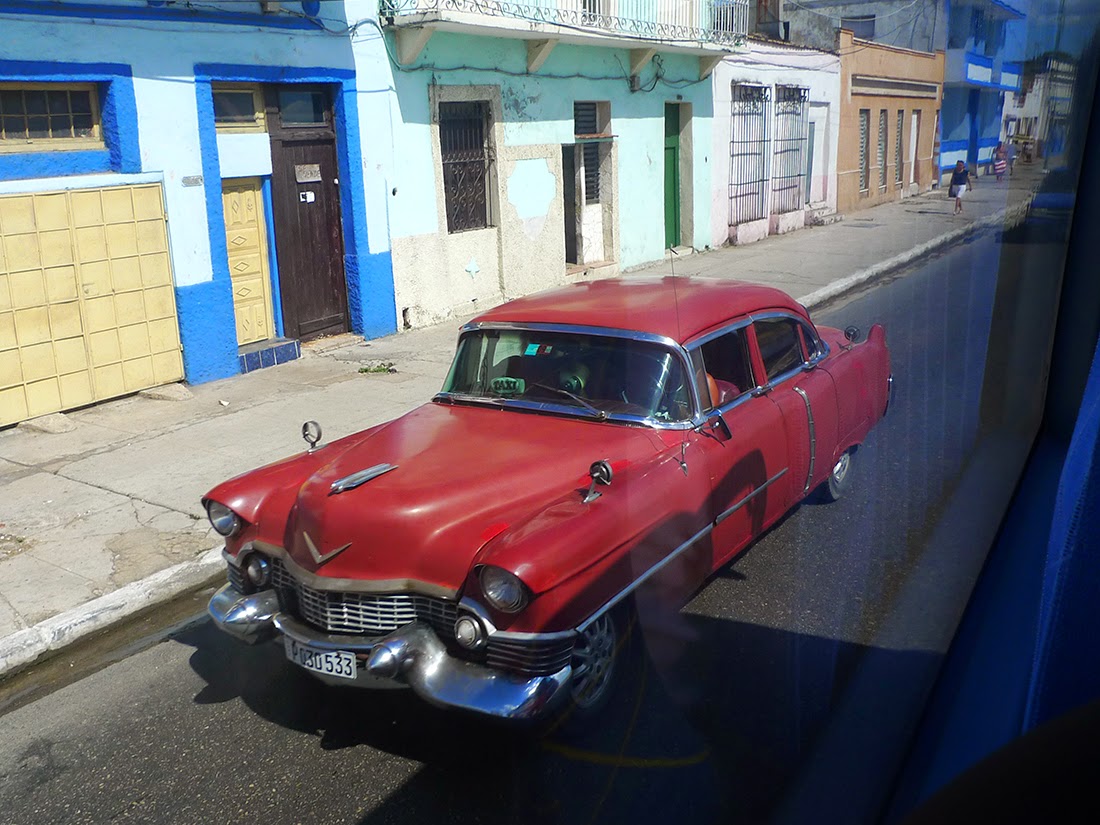 |
| Seen in passing, a 1954 Cadillac Series 62 sedan. |
↧
That mythic Mercedes Gullwing
Boy, facts sure can ruin a good story. Guess that's why Jan Richter of classicdriver.com didn't bother to look for any before reporting on a photographer's pursuit of the Mercedes Gullwing in Cubas.
According to Richter's Dec. 12 account, Piotr Degler Jablonksi had heard only rumours of the rusted-beyond-repair Gullwing before setting out to capture images of the island's classic cars for the 2015 edition of his art calendar.
"After weeks of unsuccessful searching," writes the Zurich-based Richter, "he was ready to accept it was a mere myth – until he caught a glimpse of something silver under a tree… "
Other websites, from Road & Track to Popular Mechanics, have repeated Richter's story, some with further embroidery. Top Gear suggests Degler knew nothing of the Gullwing before he arrived, but "soon got wind of a ‘legendary' 300SL rumoured by locals to lay (sic) somewhere on the island."
Autos.yahoo.com, meantime, speaks of the photographer hearing "mere whispers in the night" of a neglected Mercedes "in a remote stretch of Cuba."
That "remote stretch,"CARISTAS readers know, is the outskirts of Havana, where Miguel Llorente of This European Life photographed the Gullwing as recently as 2012.
And Degler has made clear he was well aware beforehand of the car's presence, if not its specific location. Anyone doing even the most casual research would have known about the Mercedes and its sorry state, as first documented in Michael E. Ware's Automobiles Lost & Found (Haynes Publishing, 2008) and subsequently covered by CARISTAS, Llorente, Just a Car Guy, Visit Cuba ... the list goes on.
But that would have spoiled Richter's story.
See also:
According to Richter's Dec. 12 account, Piotr Degler Jablonksi had heard only rumours of the rusted-beyond-repair Gullwing before setting out to capture images of the island's classic cars for the 2015 edition of his art calendar.
"After weeks of unsuccessful searching," writes the Zurich-based Richter, "he was ready to accept it was a mere myth – until he caught a glimpse of something silver under a tree… "
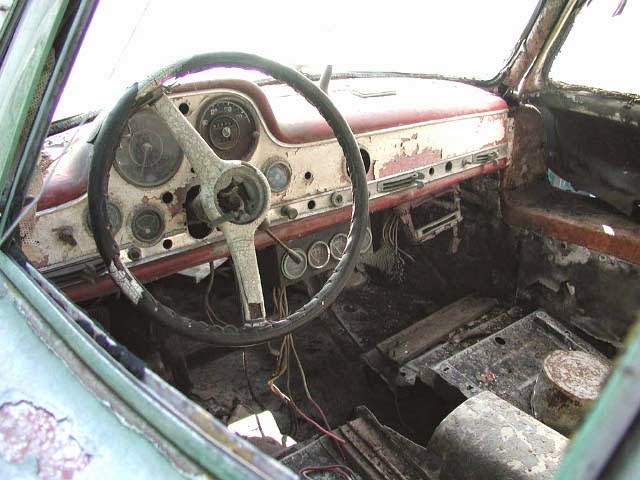 |
| Michael E. Ware photo, used by permission |
Autos.yahoo.com, meantime, speaks of the photographer hearing "mere whispers in the night" of a neglected Mercedes "in a remote stretch of Cuba."
That "remote stretch,"CARISTAS readers know, is the outskirts of Havana, where Miguel Llorente of This European Life photographed the Gullwing as recently as 2012.
And Degler has made clear he was well aware beforehand of the car's presence, if not its specific location. Anyone doing even the most casual research would have known about the Mercedes and its sorry state, as first documented in Michael E. Ware's Automobiles Lost & Found (Haynes Publishing, 2008) and subsequently covered by CARISTAS, Llorente, Just a Car Guy, Visit Cuba ... the list goes on.
But that would have spoiled Richter's story.
See also:
↧
Positively festive
↧
↧
The same the world over
↧
55 reasons why Cuba's old cars will keep on rolling
 |
| A mid-1950s Studebaker in Havana, one of as many as 60,000 old American cars in Cuba. |
One is retirement in favour of more modern vehicles. The other is their sale and export to collectors elsewhere.
Neither will happen anytime soon – and one might not happen at all. Here are five reasons why Cuba's old-timers have many more miles to travel (I know, the headline says 55, but five should be plenty):
1. The embargo remains
Barack Obama and Raúl Castro can, and did, agree to restore full diplomatic relations between the United States and Cuba, but only the U.S. Congress can rescind the 1996 Helms-Burton Act that fortified trade sanctions ordered by President John F. Kennedy 34 years earlier.
And the Republicans who hold Congress, and who do not share Obama's desire for rapprochement, will have little motivation to abandon a law that requires wholesale reform in Cuba, starting with the ouster of Raúl and Fidel Castro, before the embargo can be lifted.
That may be change, eventually, as the influence in the Republican party of old-line Cuban-Americans (aka Castro-detesters) wanes, and as the lawmakers realize their position is increasingly at odds with American voter sentiment.
Until then, however, Obama or subsequent presidents can merely tinker with the restrictions. More Americans may be able to travel to Cuba on "educational exchanges." American food producers may gain the right to sell to Cuba on credit, rather than cash-only.
But boatloads of new Ford Fusions and Chevy Impalas? Can't happen with Helms-Burton in place.
And the Republicans who hold Congress, and who do not share Obama's desire for rapprochement, will have little motivation to abandon a law that requires wholesale reform in Cuba, starting with the ouster of Raúl and Fidel Castro, before the embargo can be lifted.
That may be change, eventually, as the influence in the Republican party of old-line Cuban-Americans (aka Castro-detesters) wanes, and as the lawmakers realize their position is increasingly at odds with American voter sentiment.
Until then, however, Obama or subsequent presidents can merely tinker with the restrictions. More Americans may be able to travel to Cuba on "educational exchanges." American food producers may gain the right to sell to Cuba on credit, rather than cash-only.
But boatloads of new Ford Fusions and Chevy Impalas? Can't happen with Helms-Burton in place.
2. Cuban pockets are empty
Cuba's ally, Venezuela, which supplies its Caribbean neighbour with subsidized fuel, is staggering under runaway inflation, political turmoil and collapsing oil prices. Cuba owes its previous benefactor, Russia, some $3.2 billion U.S., even after Russia forgave 90 per cent of Cuba's Soviet-era debt.And those reforms you've heard about to allow private restaurants and similar small businesses? They are aimed more at reining in Cuba's underground economy than putting money in the hands of citizens.
Tourism and exports of nickel, sugar and medicine are keeping the lights on – mostly. But, save for a few Chinese Geelys for the police and rental fleets, there's no money for new vehicles.
3. Classic, but not so collectible
Most of Cuba's old cars are low-to-mid-range four-door sedans; nice to look at, but hardly must-haves for collectors. And most have been painted and repainted, welded and rewelded, with Volga or Toyota engines replacing their original flathead V-8s and Blue Flame 6s. Rare is the unmolested convertible or hardtop that collectors desire.True, there are some fine classics, either preserved over the decades or rebuilt by bodymen who are remarkable at their craft. But cars that would meet the collector's triple standard of rarity, desirability and condition would probably number in the hundreds, at most.
4. And who says they're for sale?
Even in the harsh days following the collapse of the Soviet Bloc, Cuba allowed only a trickle of old cars to go to outside buyers. And those were sold by the state, not by the few individuals allowed at the time to own cars and trucks.Private vehicle ownership today is open to all citizens, or at least all who can afford Cuba's mountainous car prices, but the island remains far from the unfettered auto market in which these owners could sell to foreigners.
And the government has a good reason to block such exports.
Cuba knows the value of its old cars to the tourist industry. It knows that the image of a pontoon-fendered convertible on a Havana street is as much a symbol of the island as a Montecristo cigar or Tropicana chorus dancer.
It's why Cuba already earmarks the best of its bechromed Buicks and jet-finned Dodges to serve as taxis outside hotels (even cutting off sedan roofs to create more convertibles).
That the pastel-coloured American cars are also ironic symbols of Cuban defiance might or might not register on the tourists who hire them. But when the embargo ends they will still be picturesque and charming, and they'll still make the island unique.
Cuba won't let them slip away to Scottsdale or Zurich.
5. Cuba's transportation future
In a country famous for cars, few people own vehicles. According to a University College London research paper, Cuba had just 15 cars per 1,000 inhabitants in 2008, compared to 188 in Jamaica and about 800 in the United States. Since the revolution, the priority has been public transit, mainly by purpose-built bus or converted truck.For transportation planners, Cuba is an enticing opportunity to leap straight to sophisticated, efficient mass transit, avoiding the congestion and emissions that accompanied the rapid expansion of private vehicles in places like India and China. The long and narrow island is ideal for high-speed rail; densely populated Havana stands ready for modern trams to run along its old electric-railway corridors.
When this will happen will depend on many events, within Cuba and elsewhere. But the day will come when you can cross Havana in an Alstom or Bombardier or similar light-rail car, and at the central station board a Chinese-build CRRC bullet train that will whisk you to Cienfuegos or Santiago at 350 km/h.
And as you hurtle through the countryside you will see through the window a turquoise-and-white dot that soon reveals itself as a 1955 Chevrolet Bel Air, trailing blue smoke as it dodges potholes on a two-lane road between cane fields, and just as quickly becomes smaller and smaller but, in Cuba, never quite disappears.
 |
| On the road since 1955, Ford Fairlane will likely travel many more miles yet. |
↧
Ten cars you'll see in Cuba
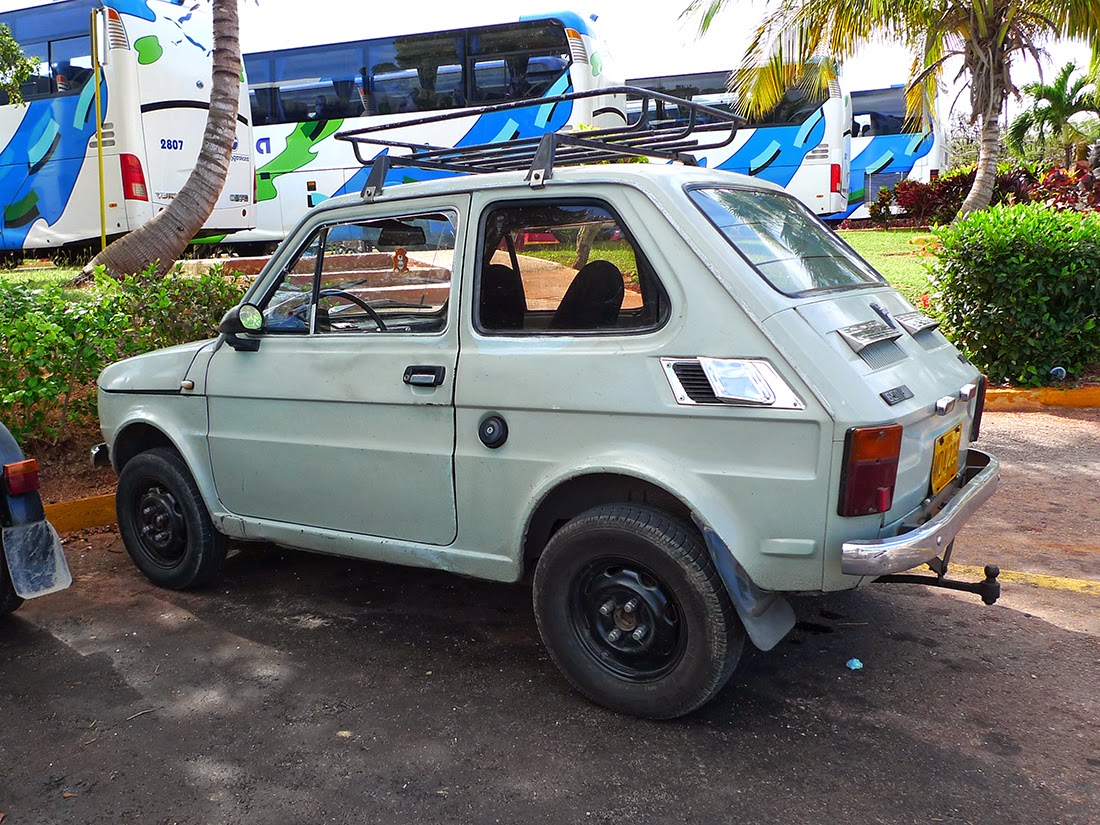 |
| The minuscule Polski Fiat 126p is one of Cuba's most affordable cars, writes Ramey, with solid construction and low operating costs. |
For the car-watcher with catholic tastes – that's catholic as in universal, not Catholic as in Popemobile – it's the mix of vehicles that makes Cuba so fascinating.
American classic, Soviet workhorse, Chinese arriviste ... you never know what you'll come across next. Cuba, writes Jay Ramey of Autoweek, is the one place "where, if a modern Geely clips your 1950s Cadillac, the traffic police are bound to arrive in a 1980s Lada."
In an entertaining car-spotter's guide to Cuba, Ramey and photographer Ramon Rivera profile 10 of the island's most popular vehicles. Some, like the 1955-through-'57 Chevrolet, will be familiar to the American buffs who now have hope of finally seeing Cuba for themselves.
In an entertaining car-spotter's guide to Cuba, Ramey and photographer Ramon Rivera profile 10 of the island's most popular vehicles. Some, like the 1955-through-'57 Chevrolet, will be familiar to the American buffs who now have hope of finally seeing Cuba for themselves.
Others, such as the Beijing BJ212 or Argentine-variant Ford Falcon, could seem wondrously strange.
Above and below are three of Ramey and Rivera's selections that I've come across: the Polski Fiat a bit strange, perhaps, the others, I'm afraid, rather prosaic. For the full list, including some more exotic entries, see the report at autoweek.com.
Above and below are three of Ramey and Rivera's selections that I've come across: the Polski Fiat a bit strange, perhaps, the others, I'm afraid, rather prosaic. For the full list, including some more exotic entries, see the report at autoweek.com.
 |
| Imported in the 1990s, the Peugeot 405 is 'the next best thing to a fully modern car in Cuba on the used car market,' says the author. |
↧
